Research on Population Spatiotemporal Aggregation Characteristics of a Small City: A Case Study on Shehong County Based on Baidu Heat Maps
Abstract
1. Introduction
2. Study Area and Methods
2.1. Study Area
2.2. Data and Preprocessing
2.2.1. Data
2.2.2. Data Preprocessing
2.3. Methods
2.3.1. Getis–Ord general G
2.3.2. Raster Data Overlay
2.3.3. Chi-Squared and Pearson Correlation Coefficient Tests
3. Results
3.1. Temporal Characteristics of Population Aggregation
3.1.1. Workday
3.1.2. Weekend
3.1.3. Comparison of the Workday and the Weekend
3.2. Spatial Distribution Characteristics of Population Aggregation
3.2.1. Workday
3.2.2. Weekend
3.2.3. Comparison of the Workday and the Weekend
3.3. Correlation between Population Aggregation and Land Parcel attributes
3.3.1. Analysis Results Based on the Land Use Parcels
3.3.2. Analysis Results Based on the Road Network Blocks
3.3.3. Analysis Results Based on Grids
4. Discussion
5. Conclusions
Author Contributions
Funding
Conflicts of Interest
Appendix A
| POI Density | Floor Area Ratio | Building Density | ||
|---|---|---|---|---|
| 30×30 m Grid | People aggregation degree | 0.636 ** | 0.0225 ** | 0.157 ** |
| Number of cases | 11605 | 11605 | 11605 | |
| 60 × 60 m Grid | People aggregation degree | 0.641 ** | 0.379 ** | 0.348 ** |
| Number of cases | 3584 | 3584 | 3584 | |
| 90 × 90 m Grid | People aggregation degree | 0.647 ** | 0.489 ** | 0.471 ** |
| Number of cases | 1762 | 1762 | 1762 | |
| 120 × 120 m Grid | People aggregation degree | 0.652 ** | 0.586 ** | 0.564 ** |
| Number of cases | 1060 | 1060 | 1060 | |
| 150 × 150 m Grid | People aggregation degree | 0.665 ** | 0.654 ** | 0.649 ** |
| Number of cases | 733 | 733 | 733 | |
| 180 × 180 m Grid | People aggregation degree | 0.670 ** | 0.699 ** | 0.668 ** |
| Number of cases | 524 | 524 | 524 | |
| 210 × 210 m Grid | People aggregation degree | 0.682 ** | 0.760 ** | 0.738 ** |
| Number of cases | 410 | 410 | 410 | |
| 240 × 240 m Grid | People aggregation degree | 0.688 ** | 0.797 ** | 0.765 ** |
| Number of cases | 327 | 327 | 327 | |
| 270 × 270 m Grid | People aggregation degree | 0.693 ** | 0.817 ** | 0.768 ** |
| Number of cases | 264 | 264 | 264 | |
| 300 × 300 m Grid | People aggregation degree | 0.700 ** | 0.850 ** | 0.792 ** |
| Number of cases | 220 | 220 | 220 | |
| 330 × 330 m Grid | People aggregation degree | 0.704 ** | 0.859 ** | 0.804 ** |
| Number of cases | 190 | 190 | 190 | |
| 360 × 360 m Grid | People aggregation degree | 0.712 ** | 0.870 ** | 0.842 ** |
| Number of cases | 155 | 155 | 155 | |
| 390 × 390 m Grid | People aggregation degree | 0.717 ** | 0.889 ** | 0.823 ** |
| Number of cases | 143 | 143 | 143 | |
| 420 × 420 m Grid | People aggregation degree | 0.705 ** | 0.904 ** | 0.845 ** |
| Number of cases | 127 | 127 | 127 | |
| 540 × 540 m Grid | People aggregation degree | 0.740 ** | 0.926 ** | 0.865 ** |
| Number of cases | 78 | 78 | 78 | |
| 780 × 780 m Grid | People aggregation degree | 0.801 ** | 0.955 ** | 0.926 ** |
| Number of cases | 48 | 48 | 48 | |
| 1290 × 1290 m Grid | People aggregation degree | 0.808 ** | 0.937 ** | 0.853 ** |
| Number of cases | 20 | 20 | 20 | |
| 1560 × 1560 m Grid | People aggregation degree | 0.887 ** | 0.974 ** | 0.949 ** |
| Number of cases | 16 | 16 | 16 | |
| 1800 × 1800 m Grid | People aggregation degree | 0.806 ** | 0.981 ** | 0.954 ** |
| Number of cases | 10 | 10 | 10 | |
| 2070 × 2070 m Grid | People aggregation degree | 0.918 ** | 0.934 ** | 0.888 ** |
| Number of cases | 10 | 10 | 10 | |
| 2310 × 2310 m Grid | People aggregation degree | 0.978 ** | 0.837 ** | 0.747 ** |
| Number of cases | 8 | 8 | 8 |
References
- Zhou, J.; Hou, Q.; Dong, W. Spatial Characteristics of Population Activities in Suburban Villages Based on Cellphone Signaling Analysis. Sustainability 2019, 11, 2159. [Google Scholar] [CrossRef]
- Sun, C.; Luo, Y.; Li, J. Urban traffic infrastructure investment and air pollution: Evidence from the 83 cities in China. J. Clean. Prod. 2018, 172, 488–496. [Google Scholar] [CrossRef]
- Sciences, C.A.O.T.; Cloud, A. 2017 Traffic Analysis Reports for Major Cities in China. Available online: http://www.cnki.com.cn/Article/CJFDTotal-CSCL201803004.htm (accessed on 26 October 2019).
- J, D.; Wang, Y.; Wang, L.; Chen, L.; Hu, B.; Tang, G.; Xin, J.; Song, T.; Wen, T.; Sun, Y.; et al. Analysis of heavy pollution episodes in selected cities of northern China. Atmos. Environ. 2012, 50, 338–348. [Google Scholar] [CrossRef]
- Ma, L.; Li, D.; Tao, X.; Dong, H.; He, B.; Ye, X. Inequality, Bi-Polarization and Mobility of Urban Infrastructure Investment in China’s Urban System. Sustainability 2017, 9, 1600. [Google Scholar] [CrossRef]
- Alfonso Piña, H.W.; Pardo Martínez, I.C. Development and Urban Sustainability: An Analysis of Efficiency Using Data Envelopment Analysis. Sustainability 2016, 8, 148. [Google Scholar] [CrossRef]
- Ma, X.; Wu, Y.-J.; Wang, Y.; Chen, F.; Liu, J. Mining smart card data for transit riders’ travel patterns. Transp. Res. Part C Emerg. Technol. 2013, 36, 1–12. [Google Scholar] [CrossRef]
- Kim, M.-K.; Kim, S.; Sohn, H.-G. Relationship between spatio-temporal travel patterns derived from smart-card data and local environmental characteristics of Seoul, Korea. Sustainability 2018, 10, 787. [Google Scholar]
- Goulet-Langlois, G.; Koutsopoulos, H.N.; Zhao, J. Inferring patterns in the multi-week activity sequences of public transport users. Transp. Res. Part C Emerg. Technol. 2016, 64, 1–16. [Google Scholar] [CrossRef]
- Gonzalez, M.C.; Hidalgo, C.A.; Barabasi, A.-L. Understanding individual human mobility patterns. Nature 2008, 453, 779. [Google Scholar] [CrossRef]
- Ahas, R.; Aasa, A.; Silm, S.; Tiru, M. Daily rhythms of suburban commuters’ movements in the Tallinn metropolitan area: Case study with mobile positioning data. Transp. Res. Part C Emerg. Technol. 2010, 18, 45–54. [Google Scholar] [CrossRef]
- Calabrese, F.; Diao, M.; Di Lorenzo, G.; Ferreira, J., Jr.; Ratti, C. Understanding individual mobility patterns from urban sensing data: A mobile phone trace example. Transp. Res. Part C Emerg. Technol. 2013, 26, 301–313. [Google Scholar] [CrossRef]
- Hoteit, S.; Secci, S.; Sobolevsky, S.; Pujolle, G.; Ratti, C. Estimating real human trajectories through mobile phone data. In Proceedings of the 2013 IEEE 14th International Conference on Mobile Data Management, Milan, Italy, 3–6 June 2013; pp. 148–153. [Google Scholar]
- Wu, Z.Q.; Ye, Z.N. Research on urban spatial structure based on Baidu heat map: A study on the central city of Shanghai. City Plan. Rev. 2016, 40, 33–40. [Google Scholar]
- He, S.; Hang, D.; Zhang, M. Research on dynamic changes of urban square space in spatial and temporal based on Baidu thermal diagram a case study on the Wuyi square of Changsha. In Proceedings of the IEEE 2nd International Conference on Big Data Analysis, Beijing, China, 10–12 March 2017. [Google Scholar]
- Jianwei, X.; Yuanfei, Z.; Tianle, Q.; Yan, L. Evaluation of downtown spatial characteristics of Nanchang. Planners 2018, 34, 120–125. [Google Scholar]
- Lucang, W. Spatial-temporal characteristics of urban population aggregation based on baidu heat map in central areas of Wuhan city. J. Hum. Settl. West China 2018, 33, 52–56. [Google Scholar]
- Reades, J.; Calabrese, F.; Ratti, C. Eigenplaces: Analysing cities using the space–time structure of the mobile phone network. Environ. Plan. B Plan. Des. 2009, 36, 824–836. [Google Scholar] [CrossRef]
- Ahas, R.; Aasa, A.; Mark, Ü.; Pae, T.; Kull, A. Seasonal tourism spaces in Estonia: Case study with mobile positioning data. Tour. Manag. 2007, 28, 898–910. [Google Scholar] [CrossRef]
- Zhang, K.; Wang, M.; Wei, B.; Sun, D.J. Identification and prediction of large pedestrian flow in urban areas based on a hybrid detection approach. Sustainability 2017, 9, 36. [Google Scholar] [CrossRef]
- Langford, M. An evaluation of small area population estimation techniques using open access ancillary data. Geogr. Anal. 2013, 45, 324–344. [Google Scholar] [CrossRef]
- Thom, D.; Bosch, H.; Koch, S.; Wörner, M.; Ertl, T. Spatiotemporal Anomaly Detection through Visual Analysis of Geolocated Twitter Messages. In Proceedings of the IEEE Pacific Visualization Symposium, Songdo, Korea, 8 Feburay–2 March 2012. [Google Scholar]
- Li, J.; Ying, L.; Dang, A. Live-Work-Play Centers of Chinese cities: Identification and temporal evolution with emerging data. Comput. Environ. Urban Syst. 2018, 71, 58–66. [Google Scholar] [CrossRef]
- Zhongnan, Y.; Yihui, C. Quantitative study on space use around urban rail transit station based on network data: A case of Shanghai metro line 10. Shanghai Urban Plan. Rev. 2017, 137, 122–128. [Google Scholar]
- Lin, L.; Difei, J. Research on The Classification Method of Historcial Streets Based on Big Data. Chin. Overseas Archit. 2016, 8, 17. [Google Scholar]
- Lihua, F.; Yaohui, P.; Zhenchun, M.; Mei, X.; Xingyan, G. Analysis on Distribution Characteristics of Business Community Center in Zhuzhou Based on Big Data. J. Nat. Sci. Hunan Norm. Univ. 2018, 41, 17–23. [Google Scholar]
- Bingrong, L.; Ying, Y.; Daquan, H.; Zheng, Y. Big data based job-residence relation in Chongqing metropolitan area. Planners 2015, 31, 92–96. [Google Scholar]
- Xin, T.; Daquan, H.; Xingshuo, Z. Research on the measurement of occupational residence balance based on Baidu heat map. J. Beijing Norm. Univ. 2016, 52, 622–627. [Google Scholar]
- Roth, C.; Kang, S.M.; Batty, M.; Barthélemy, M. Structure of urban movements: Polycentric activity and entangled hierarchical flows. PLoS ONE 2011, 6, e15923. [Google Scholar] [CrossRef] [PubMed]
- Pei, T.; Sobolevsky, S.; Ratti, C.; Shaw, S.-L.; Li, T.; Zhou, C. A new insight into land use classification based on aggregated mobile phone data. Int. J. Geogr. Inf. Sci. 2014, 28, 1988–2007. [Google Scholar] [CrossRef]
- Wang, C.; Huang, C.; Pengfei, L.I.; Wang, C. A Research on Spatio-temporal Characteristics and Motivation of Space Utilization in the Center District of City:A Case Study of Nanjing Xinjiekou Area. Mod. Urban Res. 2016, 7, 13. [Google Scholar]
- Kang, Y.; Wang, Y.; Xia, Z.; Jiao, C.; Jiao, L.; Wei, Z. Identification and Classification of Wuhan Urban Districts Based on POI. J. Geomat. 2018, 43, 81–85. [Google Scholar]
- Yao, Y.; Li, X.; Xiaoping, L.; Penghua, L.; Zhaotang, L.; Jinbao, Z.; Mai, K. Sensing spatial distribution of urban land use by integrating points-of-interest and Google Word2Vec model. Int. J. Geogr. Inf. Sci. 2016, 31, 825–848. [Google Scholar] [CrossRef]
- Xinyi, N.; Liang, D.; Xiaodong, S. Understanding Urban Spatial Structure of Shanghai Central City Based on Mobile Phone Data. China City Plan. Rev. 2015, 24, 15–23. [Google Scholar]
- Weijing, Z.; De, W. Urban space study based on the temporal characteristics of residents’ behavior. Prog. Geogr. 2018, 37, 1106–1118. [Google Scholar]
- Hao, M.; Rohrdantz, C.; Janetzko, H.; Dayal, U.; Hsu, M. Visual sentiment analysis on twitter data streams. In Proceedings of the IEEE Conference on Visual Analytics Science and Technology, Providence, RI, USA, 23–28 October 2011. [Google Scholar]
- Calabrese, F.; Colonna, M.; Lovisolo, P.; Parata, D.; Ratti, C. Real-time urban monitoring using cell phones: A case study in Rome. IEEE Trans. Intell. Transp. Syst. 2010, 12, 141–151. [Google Scholar] [CrossRef]
- Stepanyan, K.; Borau, K.; Ullrich, C. A Social Network Analysis Perspective on Student Interaction within the Twitter Microblogging Environment. In Proceedings of the 10th IEEE International Conference on Advanced Learning Technologies, Sousse, Tunisia, 5–7 July 2010. [Google Scholar]
- Mora, H.; Pérez-delHoyo, R.; Paredes-Pérez, J.; Mollá-Sirvent, R. Analysis of Social Networking Service Data for Smart Urban Planning. Sustainability 2018, 10, 4732. [Google Scholar] [CrossRef]
- Gerber, M.S. Predicting crime using Twitter and kernel density estimation. Decis. Support Syst. 2014, 61, 115–125. [Google Scholar] [CrossRef]
- Ke, C.; Jonikristian, K. Pedestrian Density Analysis in Public Scenes With Spatiotemporal Tensor Features. IEEE Trans. Intell. Transp. Syst. 2016, 17, 1968–1977. [Google Scholar]
- Tauno, M.; Jaak, V. ClustVis: A web tool for visualizing clustering of multivariate data using Principal Component Analysis and heatmap. Nucleic Acids Res. 2015, 43, W566–W570. [Google Scholar]
- Wang, W.-T.; Wu, Y.-L.; Tang, C.-Y.; Hor, M.-K. Adaptive density-based spatial clustering of applications with noise (DBSCAN) according to data. In Proceedings of the 2015 International Conference on Machine Learning and Cybernetics (ICMLC), Guangzhou, China, 12–15 July 2015; pp. 445–451. [Google Scholar]
- Jordi, D.; Schroeder, M.P.; Nuria, L. jHeatmap: An interactive heatmap viewer for the web. Bioinformatics 2014, 30, 1757–1758. [Google Scholar]
- Zhang, S.; Yang, R.; Zhao, Y. Coarse-Grained Parallel AP Clustering Algorithm based on Intra-Class and Inter-Class Distance. Int. J. Perform. Eng. 2018, 14, 3174–3183. [Google Scholar] [CrossRef]
- Baidu Map Open Platform: Intelligent Positioning. Available online: http://lbsyun.baidu.com/products/products/location (accessed on 22 October 2019).
- Han, G.; Yongpei, G.; Nana, C. Study on the population flow and population clusters in the sixth ring road of Beijing based on multivariate data. Urban Dev. Stud. 2018, 25, 107–112. [Google Scholar]
- ArcGIS Resources. Available online: http://resources.arcgis.com/en/help/main/10.2/ (accessed on 6 July 2019).
- Baohong, H.; Yan, H.; Yujia, W.; Xiang, Z. Selection Mechanisms of Residents’ Daily Activity-travel Behavior with Housing Mobility. J. Transp. Syst. Eng. Inf. Technol. 2017, 17, 19–25. [Google Scholar]
- Banker, R.D.; Morey, R.C. The Use of Categorical Variables in Data Envelopment Analysis. Manag. Sci. 1986, 32, 1613–1627. [Google Scholar] [CrossRef]
- Muller, K. Statistical Power Analysis for the Behavioral Sciences. Technometrics 1989, 31, 499–500. [Google Scholar] [CrossRef]
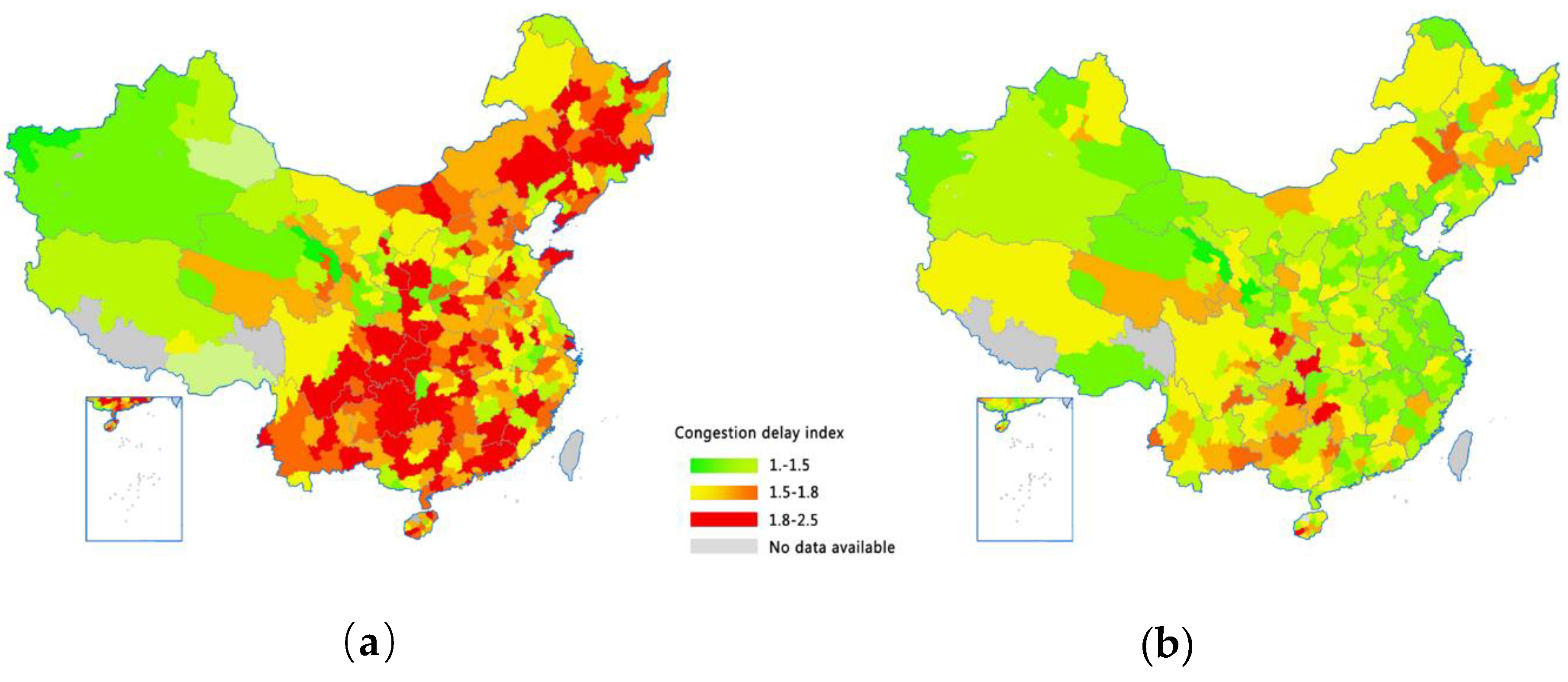

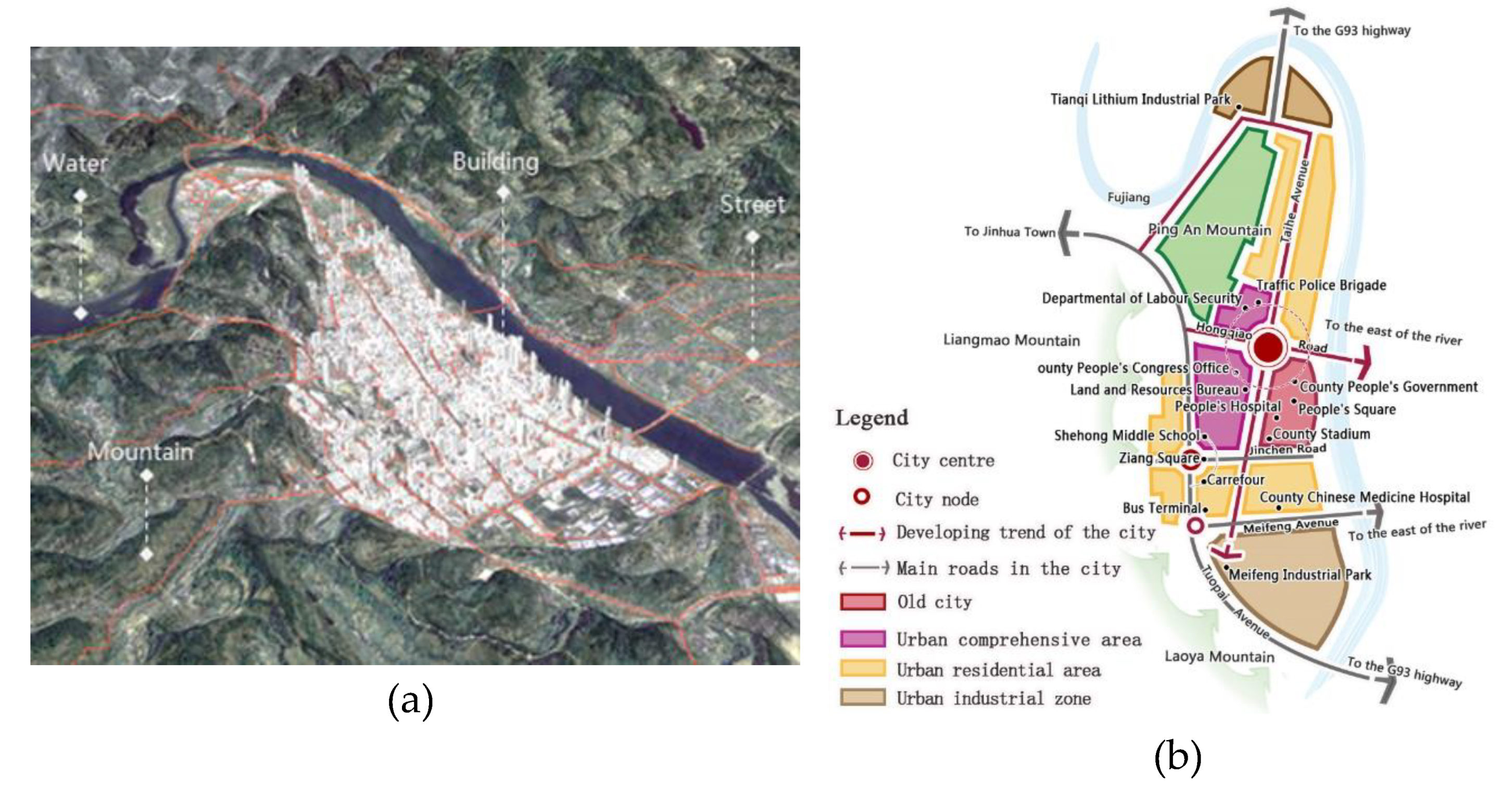

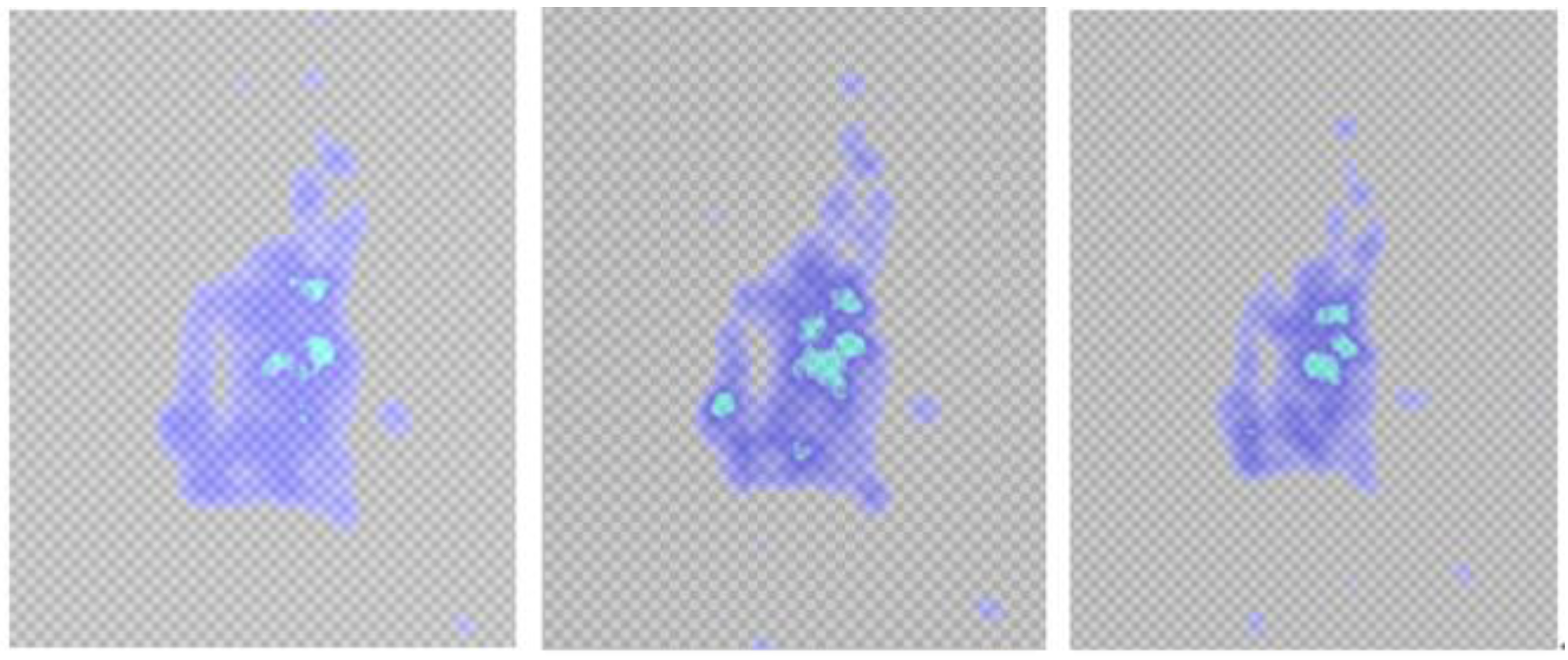

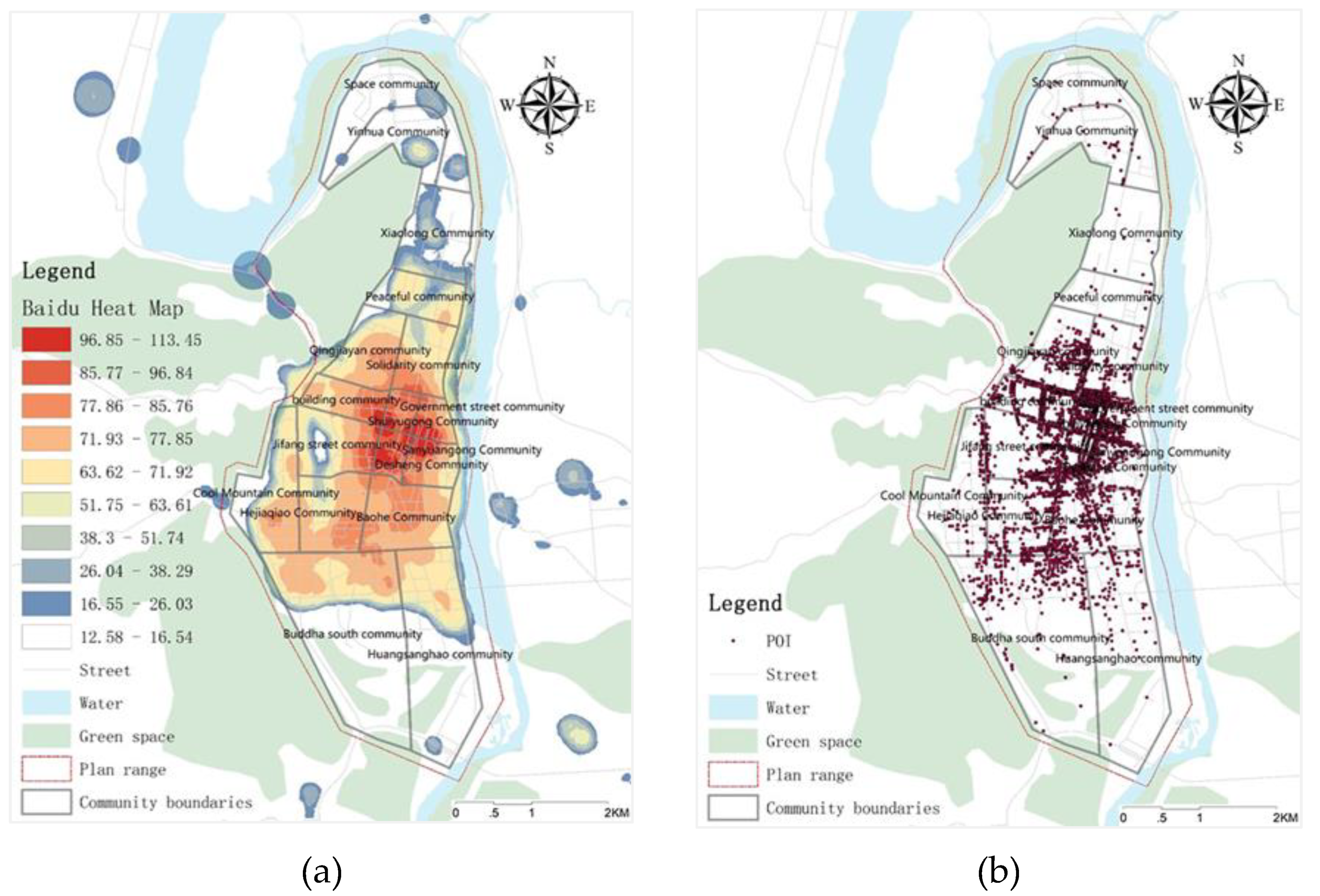

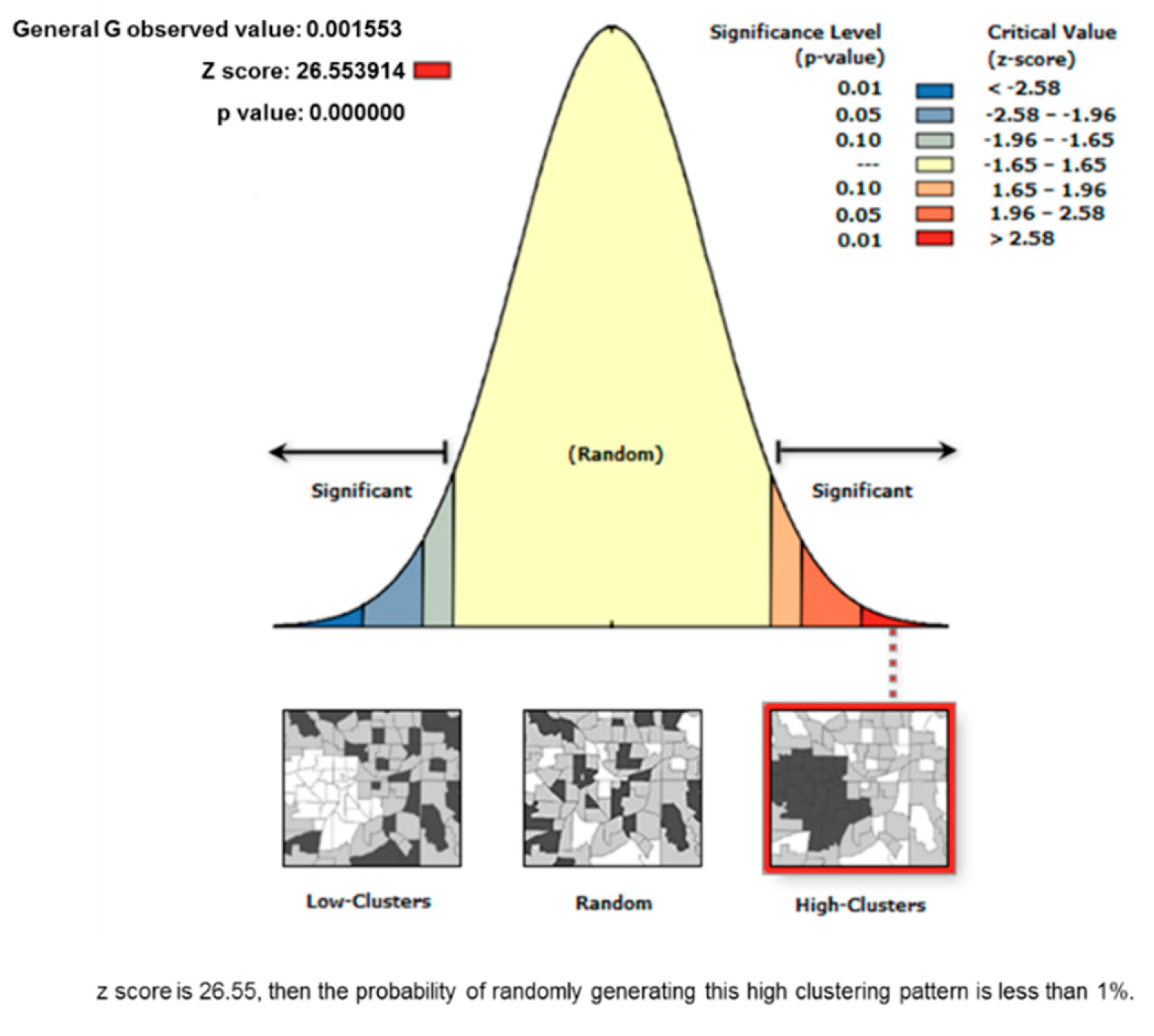


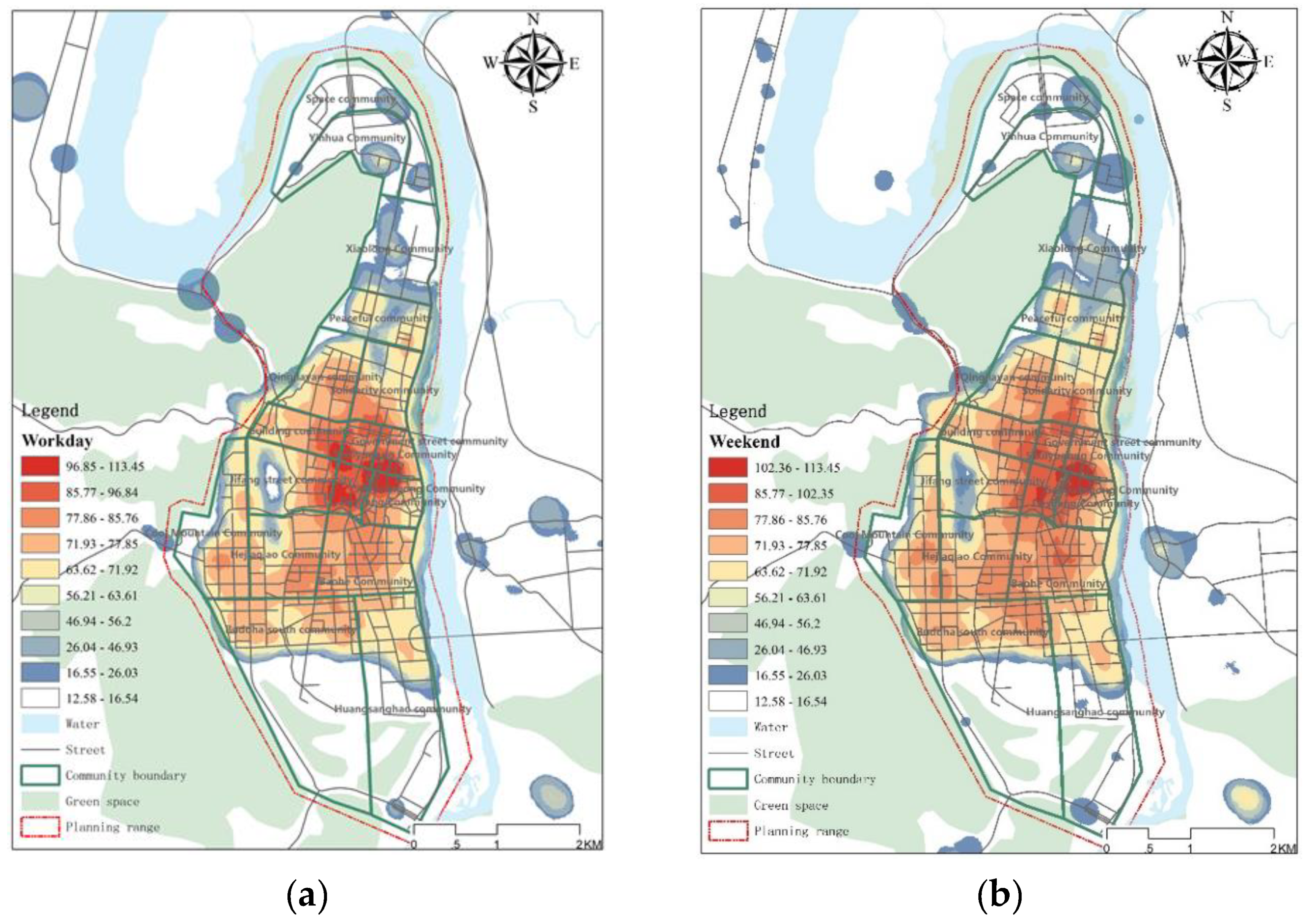
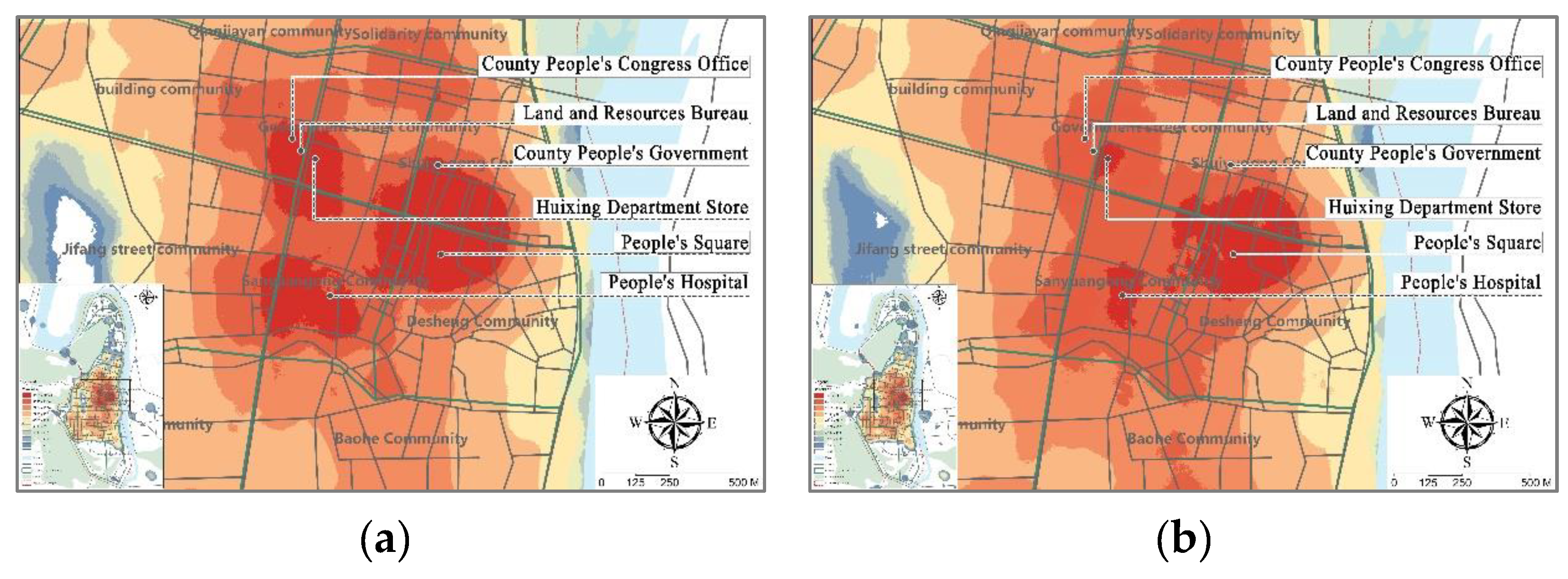
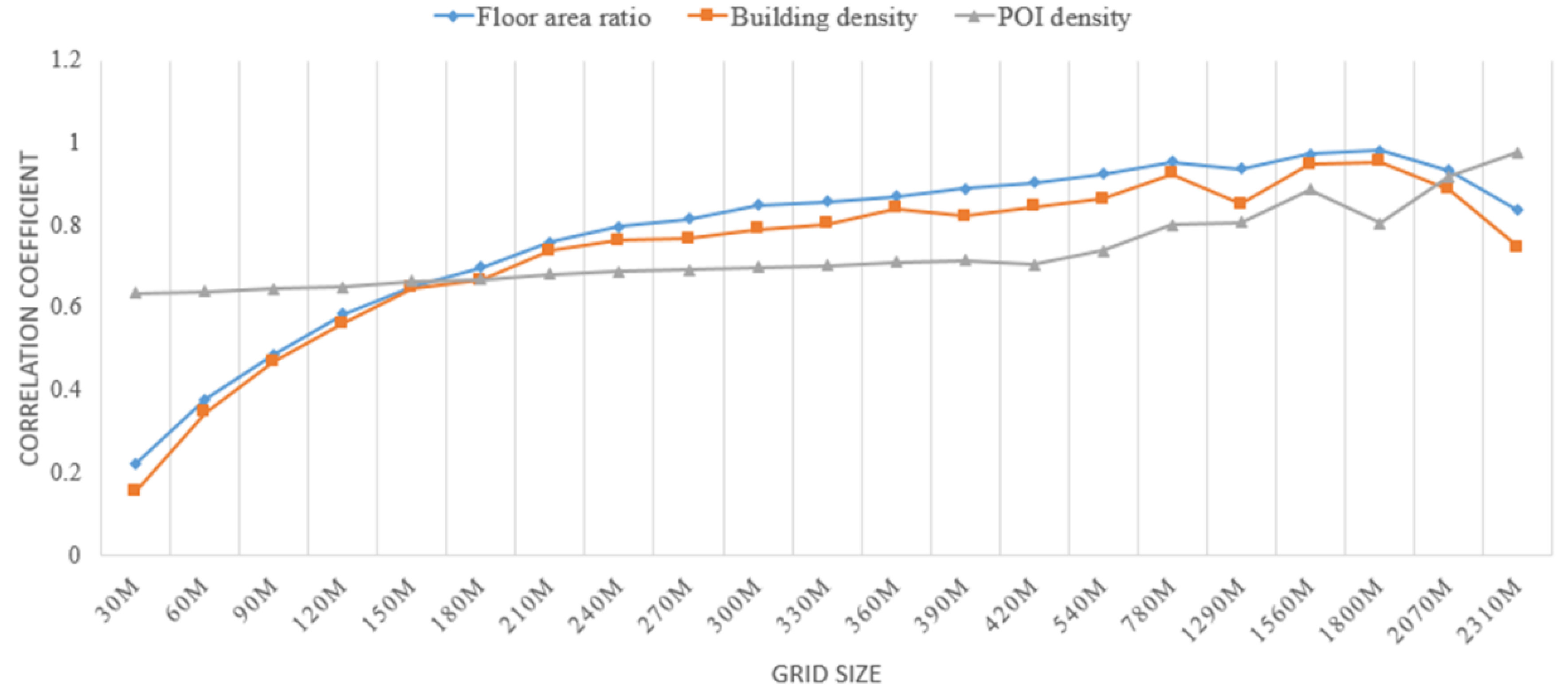
| Value | Degrees of Freedom | Progressive Significance (Two Sides) | |
|---|---|---|---|
| Pearson’s chi-squared | 12,214.195 * | 12,122 | 0.276 |
| Likelihood ratio | 2328.929 | 12,122 | 1.000 |
| Number of valid cases | 654 | 654 | 654 |
| POI Density | Floor Area Ratio | Building Density | Land Area | |
|---|---|---|---|---|
| People aggregation degree | 0.864 ** | 0.325 ** | 0.452 ** | −0.375 ** |
| Number of cases | 654 | 654 | 654 | 654 |
| POI Density | Floor Area Ratio | Building Density | Land Area | |
|---|---|---|---|---|
| People aggregation degree | 0.662 ** | 0.468 ** | 0.620 ** | −0.333 ** |
| Number of cases | 249 | 249 | 249 | 249 |
© 2019 by the authors. Licensee MDPI, Basel, Switzerland. This article is an open access article distributed under the terms and conditions of the Creative Commons Attribution (CC BY) license (http://creativecommons.org/licenses/by/4.0/).
Share and Cite
Feng, D.; Tu, L.; Sun, Z. Research on Population Spatiotemporal Aggregation Characteristics of a Small City: A Case Study on Shehong County Based on Baidu Heat Maps. Sustainability 2019, 11, 6276. https://doi.org/10.3390/su11226276
Feng D, Tu L, Sun Z. Research on Population Spatiotemporal Aggregation Characteristics of a Small City: A Case Study on Shehong County Based on Baidu Heat Maps. Sustainability. 2019; 11(22):6276. https://doi.org/10.3390/su11226276
Chicago/Turabian StyleFeng, Deyi, Lingli Tu, and Zhongwei Sun. 2019. "Research on Population Spatiotemporal Aggregation Characteristics of a Small City: A Case Study on Shehong County Based on Baidu Heat Maps" Sustainability 11, no. 22: 6276. https://doi.org/10.3390/su11226276
APA StyleFeng, D., Tu, L., & Sun, Z. (2019). Research on Population Spatiotemporal Aggregation Characteristics of a Small City: A Case Study on Shehong County Based on Baidu Heat Maps. Sustainability, 11(22), 6276. https://doi.org/10.3390/su11226276




